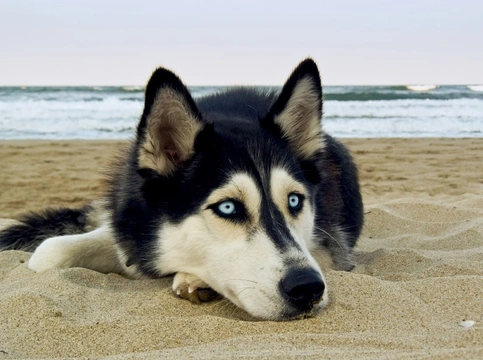
Why do Siberian huskies shed so much fur?
The Siberian husky is a large, confident and very outgoing dog breed that falls within The Kennel Club’s working grouping, and this is one breed that has become increasingly popular within the UK over the course of the last couple of decades.
However, it is also fair to say that owning, managing and caring for a Siberian husky can be challenging, and dogs of the breed benefit from being owned by people who are experienced dog owners and that understand the breed’s unique traits and how to manage them.
Siberian huskies are very high energy dogs with lots of endurance, and they need a huge amount of exercise to keep them fit, happy and well behaved. Caring for a Siberian husky and providing enough exercise for them takes up a lot of time on the part of their owners, and their need for a high level of care doesn’t stop there!
Siberian huskies also need a lot of brushing and grooming to keep their coats in good condition and free from loose hair, as well as regular baths. Huskies are very heavy shedders with thick, plush coats, and keeping shed hair under control can be a challenge that many first-time owners of dogs of the breed aren’t aware of.
If you are wondering why Siberian huskies shed so much fur and want to know what to expect from their coat care and maintenance, this article will explain everything you need to know. Read on to find out why Siberian huskies shed so much fur.
The Siberian husky coat
Siberian huskies originate from much colder climates than we’re used to here in the UK, and their coats reflect this.
Siberian husky coats are very thick and consist of different layers, which are a soft, fluffy and very dense undercoat overlain by a top layer of fur that is longer, straighter and harsher, helping to protect the dog’s body from the elements and provide insulation to keep them warm.
A very thick coat of this type is designed to help the dog weather inhospitable conditions and retain their core temperature when it’s really cold, and very hot summer days can be a challenge for dogs with a coat of this type. However, this same insulation actually helps to protect the dog from the worst of the sun too – and clipping their coats off during the summer can make it hard for huskies to regulate their own temperatures, and so this isn’t always a good idea.
How the Siberian husky coat grows
Siberians husky fur doesn’t go through seasonal stages of growth and dormancy like some other dog breeds do, and instead, they grow new fur on an ongoing basis throughout the year. The dog’s coat remains consistent throughout the year as the hairs that grow in replace those shed, although during the hotter months of the year, the coat itself will be slightly less dense – although this might not always be obvious as it is still very plush!
How and when Siberian huskies shed their fur
Because huskies continually grow new fur, they also continually shed old fur in an ongoing cycle, which means that huskies shed fur year-round and you’ll probably release some loose hair every time you pat your dog.
Coupled with this ongoing regular shedding, huskies also tend to blow their coats twice a year, shedding a much greater percentage of hair than normal over the course of a couple of weeks. These twice-annual coat blows roughly coincide with the changing of the seasons, and the onset of summer and winter respectively. The summer shed is usually the most prolonged and prolific in terms of the amount of hair they lose, and exactly when and how this happens can be variable.
If the weather heats up early on in the year, if summer is hotter than normal or if the hot weather goes on for a long time, this can affect your dog’s shedding and cause them to shed more hair and for a longer period of time too.
Managing shedding and grooming the Siberian husky
Siberian huskies need to be brushed and groomed more or less daily in order to remove loose, shed fur from their coats and stimulate the new hair growth. If you don’t groom your dog very regularly, the shed hair dropped around the house is likely to become prolific, and your dog’s coat will be full of loose, shed hair that may be itchy or uncomfortable for them.
When you groom a Siberian husky it is important to use the right selection of tools to groom right down to the roots of the undercoat and lift away shed fur, and you also need to ensure that you groom the entirety of the dog’s body and not just the flanks and easy to reach parts!
Additionally, huskies can get quite a distinct “doggy” smell to them as well, which makes regular bathing essential – every six weeks or so being ideal. Bathing your dog also helps to remove shed hair from their coat too, and this is especially valuable during times when your dog is blowing their coat.
Due to their size and the amount of fur they have, bathing a husky at home can be quite a challenge, and so many Siberian husky owners prefer to take their dogs along to a professional grooming parlour to take care of this instead.



